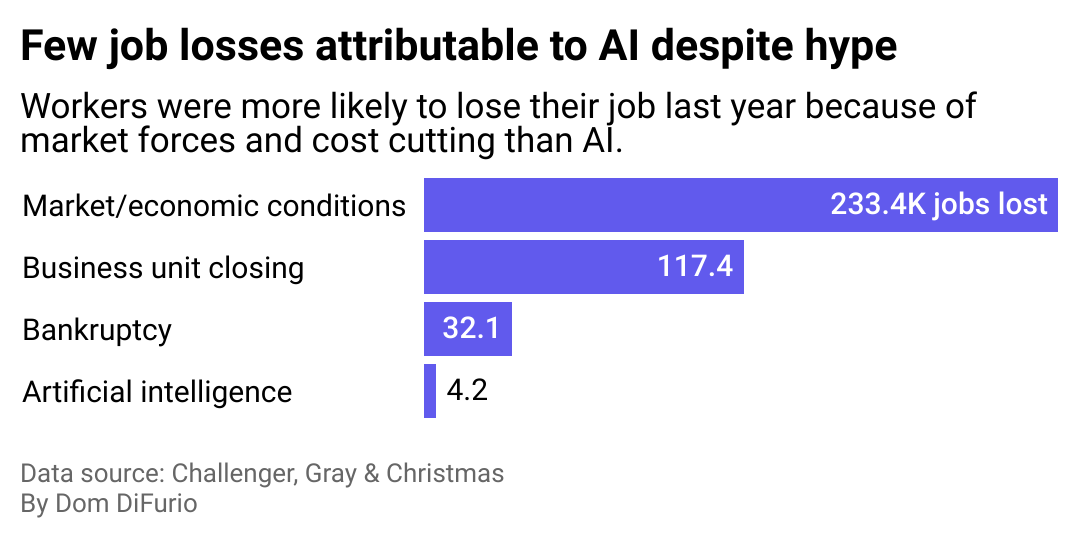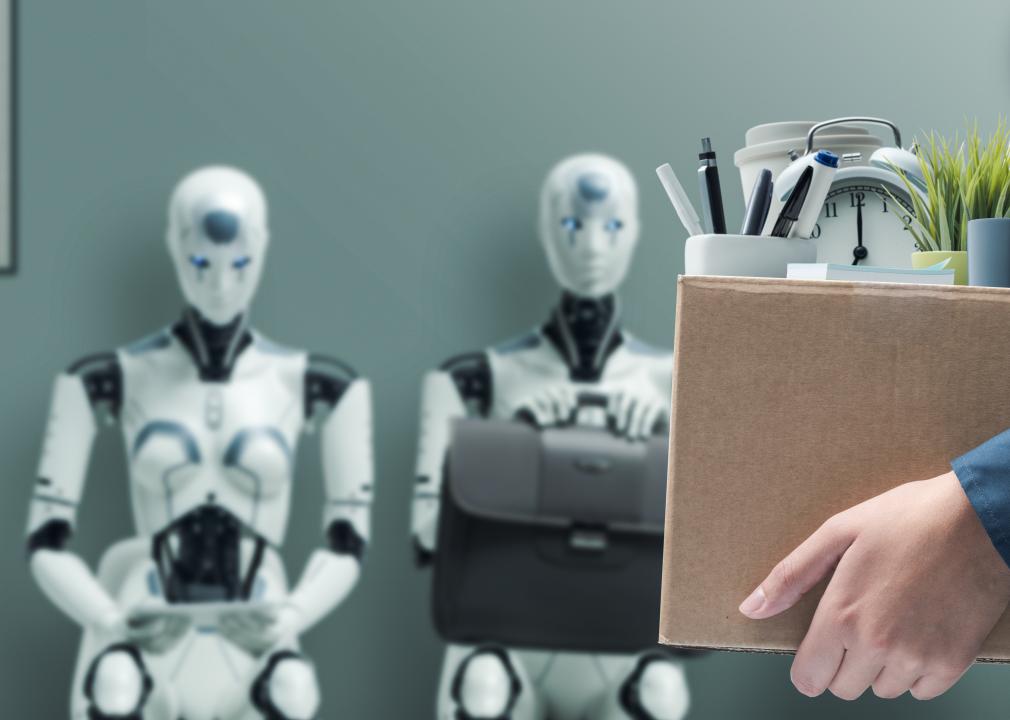How many workers can AI really replace? Estimates are all over the place.
Stokkete // Shutterstock
How many workers can AI really replace? Estimates are all over the place.
Office worker holding a box with belongings and leaving office, with AI robots waiting for job interview in the background.
Wasn’t artificial intelligence supposed to take over your job by now? A year of fear and generative AI adoption in workplaces has yet to culminate in widespread job displacement—though it’s too early to close the book on its potential to take over, according to some expert forecasts.
Verbit analyzed jobs data from Challenger, Gray & Christmas as well as Wall Street analyses and news reports to illustrate the wide range of estimates for how disruptive AI will be to human work.
Scientists, tech workers, and executives spent months in 2023 raising the alarm that the artificial intelligence applications their own companies were developing posed a threat to humanity. They alleged concerns in a brief public statement released in the spring that warned AI technology risked “extinction” for humans and called for global collaboration to mitigate it.
The statement set off a chain reaction of alarmist media coverage, public anxiety, and new initiatives at workplaces across the U.S. to get ahead of the quickly advancing tech that was described so potently by its creators. By the summer, a significant portion of chief executives who attended the Yale CEO summit said in a survey they believed AI could “destroy humanity” in five to 10 years. The fear isn’t just limited to executives: 52% of workers expressed concern about the rise of AI in a 2023 survey from the Pew Research Center.
Companies set to benefit from the widespread adoption of AI are already reaping rewards in the form of growing stock prices—helping the Nasdaq rise an impressive 43% over the course of a year in which economists worried the country might enter a recession.
Before AI can destroy humanity, we have to employ it to make decisions humans have been paid to make for centuries. But in the year since those cries from the creators of AI themselves, the threat to American jobs has thus far been opaque.
![]()

Verbit
Impact of AI minimal in job market, data suggests
A bar chart showing the top reasons companies cited for cutting jobs in 2023. Market and economic conditions led with more than 200k jobs lost, followed by 117k jobs lost due to business units closing, 32k to bankruptcy, and just 4k attributable to AI tech.
Job loss estimates over the past year suggest minimal displacement of human jobs in 2023.
The economic conditions facing U.S. companies in the aftermath of interest rate hikes, record inflation, and global conflict were the most significant job displacers. After that, companies cited the closing of a business unit and bankruptcy as the next largest reason they cut head count in 2023. Only a little more than 4,000 job cuts were considered AI-inflicted, according to the Challenger, Gray & Christmas analysis of layoff data.
Investment bankers, analysts, and researchers have made educated guesses regarding the scope of labor displacement over the next decade or more—and they’ve varied fairly dramatically.
A report from global consulting firm McKinsey estimated that nearly half of all work performed today by humans could be automated. A research memo from investment bank Goldman Sachs projected that two-thirds of jobs today will be exposed to some form of automation and one-quarter could be wholly substituted with generative AI. An even more recent analysis from researchers at the Massachusetts Institute of Technology suggests only a quarter of jobs where vision is required will be capable of full automation.
Most experts agree some fields will be more ripe for displacement early on in the development of AI, including repetitive tasks like data entry. An extension of the automation efforts that have been ongoing in factories and warehouses for decades, the new crop of AI tools has taken aim at lower-level, white-collar work.
Buy-now-pay-later payment provider Klarna boasted in February that it was able to have AI do the work of 700 employees—roughly the size of a layoff the company undertook almost two years before the announcement. The tools allowed the company to provide customer service that was in some ways better received by Klarna users than human customer service. In the same release, the company’s CEO noted “the profound impact on society that AI will have.”
But when will the robots come for the remaining 25% to 50% of jobs?
Perhaps the AI-induced stock price bubble will normalize, and layoff fears will dissipate as generative AI’s limitations become too great to ignore. The leading models still grapple with the tendency to invent misinformation or challenge direction from human users. Or perhaps we are only now seeing the earliest consequences of the AI transformation.
In the nascent days of automation in the automotive manufacturing sector, prolific inventor Norbert Wiener was able to join computer processes with machines and generated mass hysteria when he warned the implications of what he dubbed “cybernetics” could one day create mass unemployment. It wasn’t until decades later that automotive manufacturing jobs began to be culled, as hydraulic robot arms were erected in their place.
Story editing by Shannon Luders-Manuel. Copy editing by Tim Bruns.
This story originally appeared on Verbit and was produced and
distributed in partnership with Stacker Studio.
